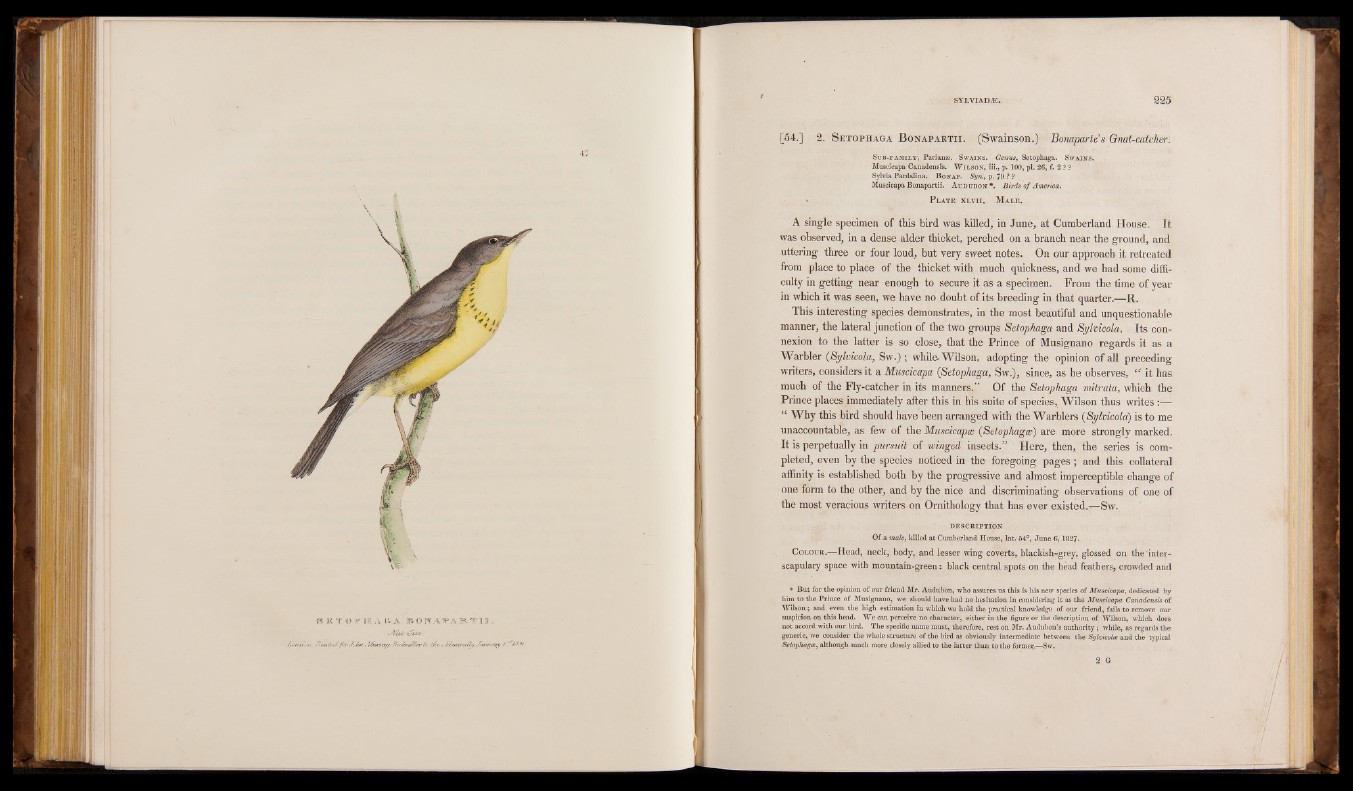
[54.] 2. S etophaga B onapaetii. (Swainson.) Bonaparte's Gnat-catcher.
Sub-f a m il y , Parian*. Sw ains. . Genus, Setophaga. Sw ain s.
Muscicapa Canadensis. W il so n , iii., p. 100, pi. 26, f. 2 ? ?
Sylvia Pardalina. B o nap. Syri.^ p. 79 ? ?
Muscicapa Bonapartii. A u d u b o n *. Birds of America.
P late xlvti. M a l e.
A single specimen of this bird was killed, in June, at Cumberland House. It
was observed, in a dense alder thicket, perched on a branch near the ground, and
uttering three or four loud, but very sweet notes. On our approach it retreated
from place to place of the thicket with much quickness, and we had some difficulty
in getting near enough to secure it as a specimen. From the time of year
in which it was seen, we have no doubt of its breeding in that quarter.—R.
This interesting species demonstrates, in the most beautiful and unquestionable
manner, the lateral junction of the two groups Setophaga and Sylmcola, Its connexion
to the latter is so close, that the Prince of Musignano regards it as a
Warbler (Sylmcola, Sw.) ; while. Wilson, adopting the opinion of all preceding
writers, considers it a Muscicapa {Setophaga, Sw.), since, as he observes, “ it has
much of the Fly-catcher in its manners.” Of the Setophaga mitrata, which the
Prince places immediately after this in his suite of species, Wilson thus writes
“ Why this bird should have been arranged with the Warblers (Sylmcola) is to me
unaccountable, as few of the Muscicapw (Setophagce) are more strongly marked.
It is perpetually in pursuit of winged insects.” Here, then, the series is completed,
even by the species noticed in the foregoing pages ; and this collateral
affinity is established both by the progressive and almost imperceptible change of
one form to the other, and by the nice and discriminating observations of one of
the most veracious writers on Ornithology that has ever existed.—Sw.
DESCRIPTION
Of a male, killed at Cumberland House, lat.-54°, June 6, 1827-
C o l o u r .—Head, neck, body, and lesser wing coverts, blackish-grey, glossed on the 'inter-
scapulary space with mountain-green: black central spots on the head feathers, crowded and
* But for the opinion of our friend Mr. Audubon, who assures us this is his new species of Muscicapa, dedicated by
him to the Prince of Musignano, we should have had uq hesitation in considering it as the Muscicapa Canadensis of
Wilson; and even the high estimation in which we hold the practical knowledge of our friend, fails to remove our
suspicion on this head. We can perceive no character, either in the figure or the description of Wilson, which does
not accord with our bird. The specific name must, therefore, rest on Mr. Audubon’s authority; while, as regards the
generic, we consider the whole structure of the bird as obviously intermediate between the Sylvicolce and the. typical
Setophagce, although much more closely allied to the latter than to the former.—Sw.
2 G